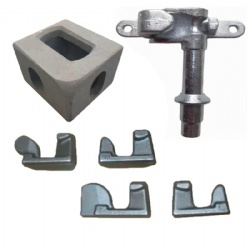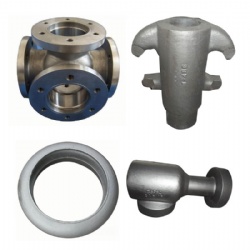Products >> Steel >>
Construction machinery parts
In the world of construction machinery, the performance and longevity of equipment heavily rely on the quality of the parts used in their construction. Cast steel parts play a pivotal role, offering strength, durability, and adaptability. This article delves into the key aspects of cast steel construction machinery parts, focusing on material composition, casting methods, microstructure control, heat treatment, surface finish, stress analysis, weldability, and fatigue resistance.
Material Composition
Cast steel is an alloy primarily composed of iron and carbon, typically containing 0.1% to 1.5% carbon along with various alloying elements. Common additions include manganese for improved toughness, nickel for enhanced corrosion resistance, and chromium for hardness. This precise blend of materials enables manufacturers to optimize mechanical properties based on specific application requirements, ensuring reliable performance under heavy loads.
Casting Methods
Sand Casting
Sand casting remains one of the most prevalent methods for producing cast steel parts. This technique involves creating a mold from sand and then pouring molten steel into it. Sand casting is particularly advantageous for large and complex components, providing excellent design flexibility. It is ideal for heavy-duty parts like frames and chassis in construction machinery.
Investment Casting
For parts requiring high precision and superior surface finish, investment casting is often preferred. This method involves creating a wax pattern, which is coated with a ceramic shell. Once the shell is hardened, the wax is melted away, leaving a detailed mold for casting. Investment casting is beneficial for smaller, intricate components, ensuring tight tolerances and reducing the need for extensive machining.
Microstructure Control
The microstructure of cast steel significantly influences its mechanical properties. Controlled cooling rates during the casting process can lead to fine-grained structures that enhance toughness and yield strength. By managing cooling effectively, manufacturers can optimize material properties to meet the rigorous demands of construction applications.
Heat Treatment
Post-casting heat treatment is crucial for achieving desired mechanical characteristics. Processes such as quenching and tempering can significantly enhance the hardness and toughness of cast steel parts. Quenching rapidly cools the material to increase hardness, while tempering reduces brittleness, allowing the part to absorb energy during impact. Understanding the thermal history and appropriate heat treatment cycles is essential for maximizing performance.
Surface Finish
The surface finish of cast steel parts can directly impact their performance and longevity. Techniques such as shot peening, grinding, and polishing are used to enhance surface characteristics. A smooth finish reduces friction and wear, while shot peening can improve fatigue resistance by inducing compressive stresses on the surface. The choice of surface treatment should align with the operational environment and specific performance requirements of construction machinery.
Stress Analysis
Conducting stress analysis is essential for predicting how cast steel parts will perform under load. Finite Element Analysis (FEA) allows engineers to simulate stress distribution and identify potential failure points during the design phase. This proactive approach helps optimize part geometry and material selection, ensuring components withstand the dynamic loads typical in construction environments.
Weldability
Weldability is a critical factor for construction machinery parts. Certain grades of cast steel are designed for easy welding, enabling repairs and modifications in the field. Understanding the appropriate pre-heating and post-weld heat treatment processes is vital to prevent cracking or distortion during welding. Manufacturers must ensure that their cast steel parts are compatible with common welding techniques used in construction applications.
Fatigue Resistance
Given the cyclic loading experienced in construction, fatigue resistance is a paramount consideration for cast steel parts. Design and material selection should account for expected load cycles. Performing fatigue testing helps assess how well parts can endure repeated stress, ensuring they maintain functionality over extended periods. This resilience is crucial for components like booms, arms, and chassis, which are subject to continuous loading and unloading.
Conclusion
For construction machines, cast steel parts are crucial, offering the strength and durability needed for demanding applications. By understanding key aspects like material composition and heat treatment, you can enhance your machinery's performance and longevity.
Ready to elevate your construction equipment with high-quality cast steel parts? Contact us today to explore tailored solutions that meet your specific needs!
Products Category
Contact Us

E-mail: [email protected]
WeChat: 18332109035
Whatsapp: 18332109035
Add: Shi Jiazhuang, He Bei Province













 WhatsApp
WhatsApp  Mail inquiry
Mail inquiry
